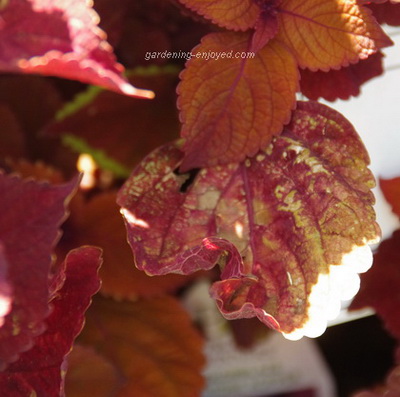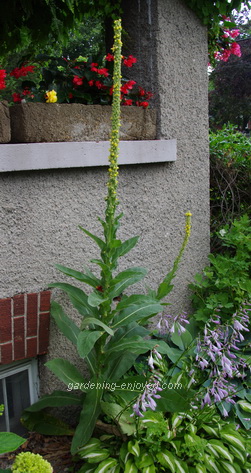
I left the garden on Thursday and drove for 2+ hours hoping that I wouldn’t be disappointed. I wasn’t. 2400 different species and varieties of annual flowers is a lot to take in with just a few hours to spend. Mel’s trials are an amazing event. He started it about 15 years ago because all of the other trials were in other parts of the world and he really wanted to know how some of those plants performed here in southern Ontario. It has grown exponentially and today is possibly the largest trial of container grown annual flowers in N. America. Most of the containers are magnificent and some are not and that is the whole point of the exercise. Most of my containers are much better this year because of my visit there last year. Fertilizer. Fertilizer. All of those 2400 containers are watered with a drip irrigation system and they are continuously fertilized and my watering can now has fertilizer in it
almost every time it is filled. It’s impossible to really absorb all that there is to see, so this year I concentrated on an old favourite, Petunias. The advances in breeding are incredible. The first five rows or so in the picture are all Petunias. There are compact varieties and rampant ones and in every colour imaginable. Some I really loved and some I wouldn’t give garden room to but that’s the reason for visiting trials such as these and no Garden Writer who was there could agree on what they must grow next year. When you are planning your garden for next year take another look at the many new and diverse varieties of Petunias, a group that has been around forever and still deserves to be well used.
 These trials are also useful for discovering potential problems. The Impatiens here collapsed a few years ago with the Downy Mildew that we all discovered. Another strain of Downy Mildew has been know to occasionally attack Coleus but never enough to create wide spread damage. These fungus diseases have conditions that they like and conditions that inhibit them. The Coleus Downy Mildew was more prevalent this year than it has been for a while. It caused some damage such as the curling and drying of the leaves that you can see in the picture but no variety suffered a significant enough attack to make the plants collapse. Whether this will continue to be the case, or whether the disease will develop and strengthen to the point where it becomes a huge problem, only time and a few dead Coleus will tell. If your Coleus have similar looking leaves turn them over and look carefully for the tiny, greenish grey, specks that are the fruiting bodies of this fungus. Carefully
remove all such leaves and destroy them. They are not a good addition to your compost. If you ever travel near the village of Simcoe, Ontario you should look up and visit the Sawaya trials and be mesmerized by the varieties on display. You too could try to see the difference between a few dozen bright red Geraniums.
These trials are also useful for discovering potential problems. The Impatiens here collapsed a few years ago with the Downy Mildew that we all discovered. Another strain of Downy Mildew has been know to occasionally attack Coleus but never enough to create wide spread damage. These fungus diseases have conditions that they like and conditions that inhibit them. The Coleus Downy Mildew was more prevalent this year than it has been for a while. It caused some damage such as the curling and drying of the leaves that you can see in the picture but no variety suffered a significant enough attack to make the plants collapse. Whether this will continue to be the case, or whether the disease will develop and strengthen to the point where it becomes a huge problem, only time and a few dead Coleus will tell. If your Coleus have similar looking leaves turn them over and look carefully for the tiny, greenish grey, specks that are the fruiting bodies of this fungus. Carefully
remove all such leaves and destroy them. They are not a good addition to your compost. If you ever travel near the village of Simcoe, Ontario you should look up and visit the Sawaya trials and be mesmerized by the varieties on display. You too could try to see the difference between a few dozen bright red Geraniums.
 Not everything in a garden goes according to plan. A weed is just a plant growing where you don’t want it to grow. In my garden this year I have ripped out many Tomato plants that seeded themselves between the rows of Lettuce and Potatoes. Despite the very cold winter, those Tomato seeds remained viable and germinated at the first warming of the soil. Beside the house, in the entrance to my service area I have found this wonderful sentry standing guard. In most places Mullein, Verbascum sp. might be considered a weed but here it is a magnificent specimen and I’m not about to remove it. There are many species of Mullein and even some that have been hybridized as garden ornamentals. We know them mostly as stately weeds that inhabit dry and somewhat inhospitable soils. Mine grows close to house in some very gravelly soil and certainly never receives any of that fertilizer that I am so generously providing to my containers.
Not everything in a garden goes according to plan. A weed is just a plant growing where you don’t want it to grow. In my garden this year I have ripped out many Tomato plants that seeded themselves between the rows of Lettuce and Potatoes. Despite the very cold winter, those Tomato seeds remained viable and germinated at the first warming of the soil. Beside the house, in the entrance to my service area I have found this wonderful sentry standing guard. In most places Mullein, Verbascum sp. might be considered a weed but here it is a magnificent specimen and I’m not about to remove it. There are many species of Mullein and even some that have been hybridized as garden ornamentals. We know them mostly as stately weeds that inhabit dry and somewhat inhospitable soils. Mine grows close to house in some very gravelly soil and certainly never receives any of that fertilizer that I am so generously providing to my containers.
Now it’s time to answer
a few of my reader’s questions. Don’t forget to check the front page of the Website for frequent short ideas for current gardening activities.
Shirley Asks? Friends of mine have a lovely property with a forest behind them. The dog strangling vine is very rampant and they have applied Roundup, which of course is killing other plants. They have tried digging, but there is too much.
Ken Answers! Dog strangling vine is very difficult to control and the strength of Roundup that is now available will have minimal effect. Several applications may eventually work. Digging is a difficult option as any bits of root that are left will start to grow again. Make sure that any seed pods are not allowed to develop. Here is a government website to check out although it's not very
encouraging.
Rebecca Asks? My garden and yard are backed by woods and very shady. I have a “wall” of Virginia Creeper on a lattice fence that disguises our propane tank which gets about a half day of direct sun. The vine is thick and needs frequent trimming to control, however, it is covered in white spots that detracts from its lushness if you’re up close to it. I’ve tried insecticidal soap but that doesn’t work. It looks as though something is laying tiny eggs all over the leaves. Any suggestions would be helpful and thank-you.
Ken Answers! Such things are hard to diagnose from written descriptions but here goes an attempt. Powdery mildew will occur on Virginia creeper and it will start out as a mass of white spots. Those spots will continue to increase until most of the leaf is covered. There is little that you can do that is worth the effort. It will return in any year when you have warm dry weather with high humidity. My faithful
spray of 1 part milk to 9 parts water works on Powdery Mildew on many things and may retard its advance on your vine.
111 Trent St. W.
Whitby ON
L1N1L9
|

 These trials are also useful for discovering potential problems. The Impatiens here collapsed a few years ago with the Downy Mildew that we all discovered. Another strain of Downy Mildew has been know to occasionally attack Coleus but never enough to create wide spread damage. These fungus diseases have conditions that they like and conditions that inhibit them. The Coleus Downy Mildew was more prevalent this year than it has been for a while. It caused some damage such as the curling and drying of the leaves that you can see in the picture but no variety suffered a significant enough attack to make the plants collapse. Whether this will continue to be the case, or whether the disease will develop and strengthen to the point where it becomes a huge problem, only time and a few dead Coleus will tell. If your Coleus have similar looking leaves turn them over and look carefully for the tiny, greenish grey, specks that are the fruiting bodies of this fungus. Carefully
remove all such leaves and destroy them. They are not a good addition to your compost. If you ever travel near the village of Simcoe, Ontario you should look up and visit the Sawaya trials and be mesmerized by the varieties on display. You too could try to see the difference between a few dozen bright red Geraniums.
These trials are also useful for discovering potential problems. The Impatiens here collapsed a few years ago with the Downy Mildew that we all discovered. Another strain of Downy Mildew has been know to occasionally attack Coleus but never enough to create wide spread damage. These fungus diseases have conditions that they like and conditions that inhibit them. The Coleus Downy Mildew was more prevalent this year than it has been for a while. It caused some damage such as the curling and drying of the leaves that you can see in the picture but no variety suffered a significant enough attack to make the plants collapse. Whether this will continue to be the case, or whether the disease will develop and strengthen to the point where it becomes a huge problem, only time and a few dead Coleus will tell. If your Coleus have similar looking leaves turn them over and look carefully for the tiny, greenish grey, specks that are the fruiting bodies of this fungus. Carefully
remove all such leaves and destroy them. They are not a good addition to your compost. If you ever travel near the village of Simcoe, Ontario you should look up and visit the Sawaya trials and be mesmerized by the varieties on display. You too could try to see the difference between a few dozen bright red Geraniums. Not everything in a garden goes according to plan. A weed is just a plant growing where you don’t want it to grow. In my garden this year I have ripped out many Tomato plants that seeded themselves between the rows of Lettuce and Potatoes. Despite the very cold winter, those Tomato seeds remained viable and germinated at the first warming of the soil. Beside the house, in the entrance to my service area I have found this wonderful sentry standing guard. In most places Mullein, Verbascum sp. might be considered a weed but here it is a magnificent specimen and I’m not about to remove it. There are many species of Mullein and even some that have been hybridized as garden ornamentals. We know them mostly as stately weeds that inhabit dry and somewhat inhospitable soils. Mine grows close to house in some very gravelly soil and certainly never receives any of that fertilizer that I am so generously providing to my containers.
Not everything in a garden goes according to plan. A weed is just a plant growing where you don’t want it to grow. In my garden this year I have ripped out many Tomato plants that seeded themselves between the rows of Lettuce and Potatoes. Despite the very cold winter, those Tomato seeds remained viable and germinated at the first warming of the soil. Beside the house, in the entrance to my service area I have found this wonderful sentry standing guard. In most places Mullein, Verbascum sp. might be considered a weed but here it is a magnificent specimen and I’m not about to remove it. There are many species of Mullein and even some that have been hybridized as garden ornamentals. We know them mostly as stately weeds that inhabit dry and somewhat inhospitable soils. Mine grows close to house in some very gravelly soil and certainly never receives any of that fertilizer that I am so generously providing to my containers.